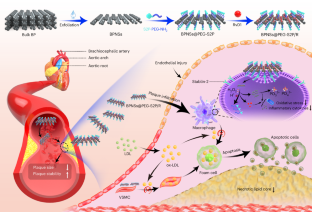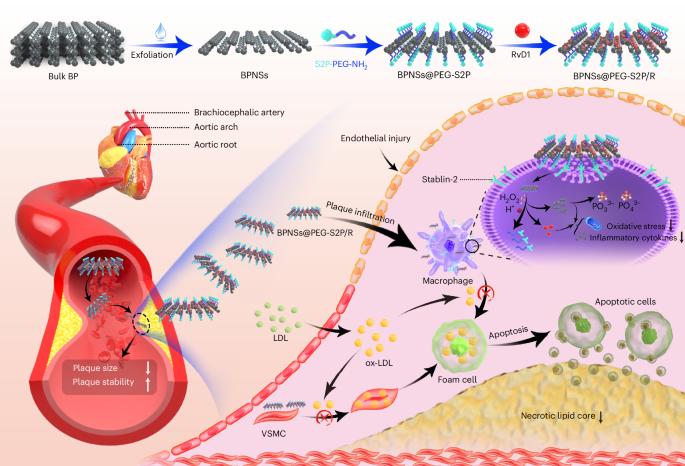Resolvin D1 delivery to lesional macrophages using antioxidative black phosphorus nanosheets for atherosclerosis treatment
IF 38.1
1区 材料科学
Q1 MATERIALS SCIENCE, MULTIDISCIPLINARY
引用次数: 0
Abstract
The buildup of plaques in atherosclerosis leads to cardiovascular events, with chronic unresolved inflammation and overproduction of reactive oxygen species (ROS) being major drivers of plaque progression. Nanotherapeutics that can resolve inflammation and scavenge ROS have the potential to treat atherosclerosis. Here we demonstrate the potential of black phosphorus nanosheets (BPNSs) as a therapeutic agent for the treatment of atherosclerosis. BPNSs can effectively scavenge a broad spectrum of ROS and suppress atherosclerosis-associated pro-inflammatory cytokine production in lesional macrophages. We also demonstrate ROS-responsive, targeted-peptide-modified BPNS-based carriers for the delivery of resolvin D1 (an inflammation-resolving lipid mediator) to lesional macrophages, which further boosts the anti-atherosclerotic efficacy. The targeted nanotherapeutics not only reduce plaque areas but also substantially improve plaque stability in high-fat-diet-fed apolipoprotein E-deficient mice. This study presents a therapeutic strategy against atherosclerosis, and highlights the potential of BPNS-based therapeutics to treat other inflammatory diseases. Targeted black phosphorus nanosheet-based therapeutics that efficiently deliver resolvin D1 to lesional macrophages for the treatment of atherosclerosis by reducing oxidative stress and resolving inflammation have been discussed.


利用抗氧化黑磷纳米片向病变巨噬细胞输送 Resolvin D1 以治疗动脉粥样硬化
动脉粥样硬化中斑块的堆积会导致心血管事件,而长期未解决的炎症和活性氧(ROS)的过度产生是斑块进展的主要驱动因素。能够消除炎症和清除 ROS 的纳米疗法具有治疗动脉粥样硬化的潜力。在这里,我们展示了黑磷纳米片(BPNSs)作为一种治疗剂治疗动脉粥样硬化的潜力。黑磷纳米片能有效清除多种 ROS,并抑制动脉粥样硬化相关的促炎细胞因子在病变巨噬细胞中的产生。我们还展示了具有 ROS 响应的靶向肽修饰 BPNS 载体,用于向病变巨噬细胞递送 resolvin D1(一种消炎脂质介质),从而进一步提高抗动脉粥样硬化的疗效。这种靶向纳米治疗药物不仅能减少斑块面积,还能显著改善高脂饮食载脂蛋白E缺陷小鼠斑块的稳定性。这项研究提出了一种抗动脉粥样硬化的治疗策略,并强调了基于 BPNS 的疗法治疗其他炎症性疾病的潜力。
本文章由计算机程序翻译,如有差异,请以英文原文为准。
求助全文
约1分钟内获得全文
求助全文
来源期刊

Nature nanotechnology
工程技术-材料科学:综合
CiteScore
59.70
自引率
0.80%
发文量
196
审稿时长
4-8 weeks
期刊介绍:
Nature Nanotechnology is a prestigious journal that publishes high-quality papers in various areas of nanoscience and nanotechnology. The journal focuses on the design, characterization, and production of structures, devices, and systems that manipulate and control materials at atomic, molecular, and macromolecular scales. It encompasses both bottom-up and top-down approaches, as well as their combinations.
Furthermore, Nature Nanotechnology fosters the exchange of ideas among researchers from diverse disciplines such as chemistry, physics, material science, biomedical research, engineering, and more. It promotes collaboration at the forefront of this multidisciplinary field. The journal covers a wide range of topics, from fundamental research in physics, chemistry, and biology, including computational work and simulations, to the development of innovative devices and technologies for various industrial sectors such as information technology, medicine, manufacturing, high-performance materials, energy, and environmental technologies. It includes coverage of organic, inorganic, and hybrid materials.
 求助内容:
求助内容: 应助结果提醒方式:
应助结果提醒方式:


